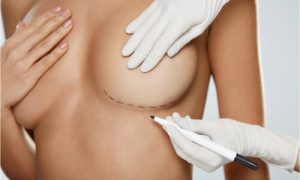Breast augmentation scars are a concern for breast enlargement patients. The scarring from breast augmentation is typically much less noticeable than breast reduction or mastectomy. However, it can still be bothersome to some people. This blog post will discuss the different types of breast augmentation scars and how they should be managed to prevent them. We will also talk about what you should do if you have already developed breast implants scars and make sure they fade as quickly as possible.
What is Breast Augmentation Surgery?
Breast augmentation is a cosmetic medical procedure that uses breast implants or fat grafting to enlarge, lift and make the breast fuller.
The cosmetic doctor will do the breast implant surgery by inserting an implant filled with either saline solution or oil into the breast through an incision in the breast fold (inframammary region). The breast-implant volume will depend on the patient’s breast measurements, age, and breast characteristics.
What is Breast Surgery Scars?
Breast augmentation scars are surgically-created skin scars that develop after breast reduction, breast lift, breast reconstruction, or breast augmentation surgery. Scars usually result from using a scalpel or cauterizing instruments to open up the breast tissue during these procedures. These breast deformities can cause physical (e.g., rashes, bumps and indentations) and psychological (e.g., fear of breast cancer recurrence) problems for breast surgery patients. Prolonged breast scars may also cause breast skin overstretching, leading to skin sagging in the breast area. There is a growing interest in using laser technology for breast reduction and breast lift procedures to minimize breast scars.
Types of Breast Augmentation Scars
Cosmetic procedures, like any type of surgical procedure may always have surgery risks and complications. In fact, in the case of cosmetic breast surgery, scarring may appear after the procedure.
In any case, some types of breast implant scars may include:
Periareolar incision
For periareolar incision, the surgeon creates an incision around the areola. This type of incision can result in a wide scar that may be difficult to hide under clothing. However, it is often less visible than other types of scars.
To manage this kind of scar, you can follow these tips:
- Use pressure and elevation to reduce swelling.
- Apply a compression garment to help reduce swelling and breast size.
- Avoid strenuous activity for the first few weeks after surgery.
Inframammary fold incision
This scar affects the breast crease. The inframammary fold incision has more visible scars than other breast augmentation scars. Still, it is also often less visible than other breast augmentation scars.
The scar management for this type is similar to periareolar incision, which includes:
- Use pressure and elevation to reduce swelling.
- Apply a compression garment to help reduce swelling and breast size.
- Avoid strenuous activity for the first few weeks after surgery.
T-Shaped Incision
The T-shaped incision includes an anchor-shaped vertical incision and a shorter horizontal incision. This type of breast augmentation scar is the most visible, but it also has the lowest rate of complications.
In any case, you can try the following to manage hypertrophic or keloid scarring:
- Use pressure and elevation to reduce swelling.
- Apply a compression garment to help reduce swelling and breast size.
- Avoid strenuous activity for the first few weeks after surgery.
- After breast augmentation, avoid underwire bras for the first few weeks.
- If you experience pain or discomfort, contact your surgeon.
- Be sure to follow all postoperative instructions carefully.
Three Ways to Minimize Scar Appearance
A scar is the body’s natural way of healing itself after an injury. Still, it can be unsightly or uncomfortable for breast augmentation patients. Fortunately, there are ways to reduce the appearance of breast augmentation scars to less noticeable.
Examine Your Scars
Patients can be their own best advocates in the breast augmentation healing process by closely examining their breast augmentation scars and speaking with their cosmetic doctor about any questions or concerns. It is important to remember that breast augmentation scars will fade over time. Still, suppose they seem too prominent in the early postoperative period. In that case, the cosmetic doctor might be able to help somehow.
Minimize Skin Exposure
For breast augmentation patients concerned about breast implant visibility because of skin exposure – such as while wearing a swimsuit or low-cut top – breast augmentation surgery under the muscle offers many advantages. Under the muscle, breast implants are not entirely covered by existing breast tissues. Still, they are placed under the breast tissue for added support.
Consider Scar Camouflage Treatments
There are scar camouflage treatments available for breast augmentation patients who are still troubled by the appearance of their breast augmentation scars. These treatments involve the use of topical creams or lasers that help to reduce the visibility of scars. In fact, they can also treat scars from other procedures like breast lift scars.
How To Prevent Scars After Breast Implant Surgery
There are also ways to prevent breast augmentation scars from forming in the first place.
Follow Aftercare Instructions
It is essential for breast augmentation patients to closely follow their surgeon’s aftercare instructions to minimize the risk of infection or other complications that could lead to scars. This includes keeping  the surgical area clean and dry and avoiding strenuous activity for the first few weeks after surgery.
the surgical area clean and dry and avoiding strenuous activity for the first few weeks after surgery.
Use Topical Solutions
Several topical solutions can be applied to breast augmentation scars to promote healing and reduce the appearance of scars. These solutions might include silicone gel pads, vitamin E oil, or special scar creams.
Consider Laser Treatment
Laser treatment is another option for breast augmentation patients concerned about the appearance of their scars. This treatment uses a laser to help break down the scar tissue and promote healing.
No matter what approach is taken, breast augmentation scars will eventually fade. Still, it is essential to be patient and closely follow the surgeon’s instructions. With extra care, breast augmentation scars can be greatly minimized.
Final Thought
The first thing you should know about breast augmentation surgery scars is that they will be different for everyone. There is no one-size-fits-all scar treatment, and what works for one person may not work as well for another.
Suppose you want to be certain about the appearance of your scars. In that case, it is best to consult with a qualified cosmetic doctor before making any decisions. It is also essential for patients to know their options to make an educated decision when choosing breast augmentation surgery or another kind of cosmetic procedure. For more information on how we handle breast augmentation surgical procedures in our office, call us today at (02) 8188 3775. We are happy to answer all of your questions and help you make the best possible decision for your unique situation.
References:
https://www.ncbi.nlm.nih.gov/pmc/articles/PMC5103926/
https://www.medicalnewstoday.com/articles/319211
https://www.aad.org/public/cosmetic/scars-stretch-marks/laser-treatment-scar


Recent Comments